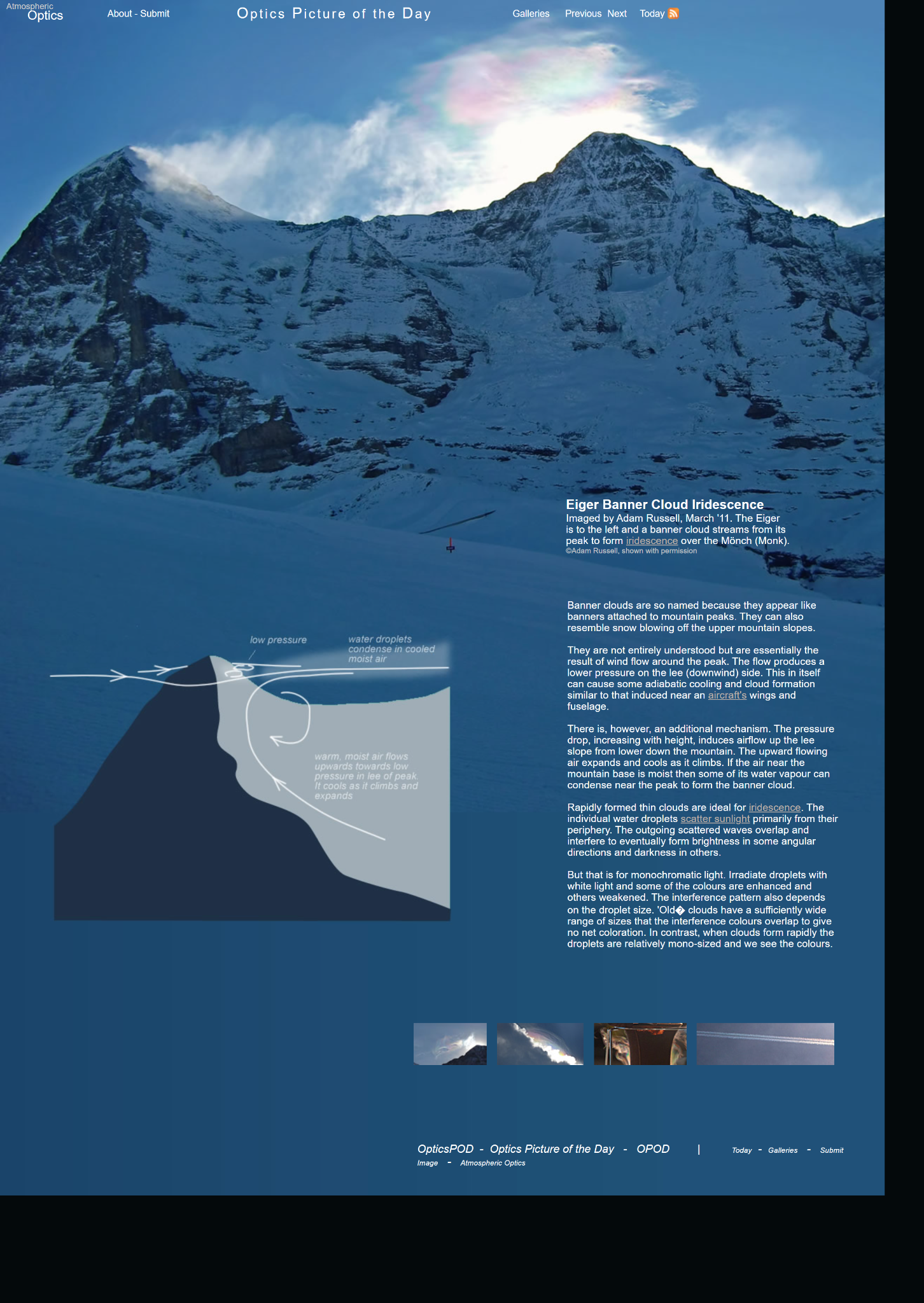OPOD - Eiger Banner Cloud Iridescence
OPOD - Eiger Banner Cloud Iridescence: A Spectacular Atmospheric Phenomenon
Have you ever witnessed a breathtaking display of colors in the sky? One such phenomenon is the Eiger Banner Cloud Iridescence. Captured by Adam Russell in March '11, this mesmerizing optical effect occurs when a banner cloud forms over the Mönch (Monk) peak, creating a stunning display of iridescent hues. In this article, we will delve into the intricacies of this atmospheric phenomenon and explore the science behind its formation.
Banner clouds, aptly named for their resemblance to banners attached to mountain peaks, are a fascinating sight to behold. They can also appear as snow being blown off the upper slopes of a mountain. Although not fully understood, these clouds are primarily formed due to the wind flow around the peak. As the wind encounters the mountain, it creates a lower pressure on the downwind side. This pressure drop induces adiabatic cooling, similar to the phenomenon observed near an aircraft's wings and fuselage, leading to cloud formation.
However, there is an additional mechanism at play in the formation of banner clouds. The increasing pressure drop with height induces an upward airflow on the lee slope of the mountain, originating from lower down the mountain. As this air ascends, it expands and cools. If the air near the base of the mountain contains sufficient moisture, some of its water vapor can condense near the peak, giving rise to the formation of the captivating banner cloud.
One of the key factors that contribute to the mesmerizing iridescence of these banner clouds is their rapid formation and thinness. Thin clouds that form quickly provide an ideal canvas for iridescence to occur. When sunlight interacts with individual water droplets in these clouds, the droplets scatter light primarily from their periphery. The outgoing scattered waves overlap and interfere with each other, resulting in the formation of brightness in certain angular directions and darkness in others.
It is important to note that the phenomenon of iridescence is most pronounced with monochromatic light. When white light, which consists of a range of colors, illuminates the droplets, some colors are enhanced while others are weakened. The specific interference pattern observed also depends on the size of the droplets. "Old" clouds, which have a wide range of droplet sizes, exhibit overlapping interference colors that cancel each other out, resulting in no net coloration. On the other hand, when clouds form rapidly, the droplets tend to be relatively uniform in size, allowing us to witness the vibrant display of colors associated with iridescence.
The Eiger Banner Cloud Iridescence serves as a reminder of the awe-inspiring beauty that can be found in our atmosphere. While the exact conditions required for this phenomenon to occur may not be fully understood, the interplay of wind flow, pressure differentials, and moisture content contribute to the formation of these captivating clouds. The rapid formation of thin clouds and the unique properties of light interference give rise to the iridescent colors that leave us in awe of nature's wonders.
In conclusion, witnessing the Eiger Banner Cloud Iridescence is a truly remarkable experience. As we continue to unravel the mysteries of our atmosphere, these captivating optical phenomena remind us of the intricate processes that shape our world. So, next time you find yourself gazing at the sky, keep an eye out for these enchanting banner clouds and prepare to be mesmerized by their iridescent splendor.

Eiger Banner Cloud Iridescence Imaged by Adam Russell, March '11. The Eiger is to the left and a banner cloud streams from its peak to form iridescence over the Mönch (Monk).
©Adam Russell, shown with permission
Banner clouds are so named because they appear like banners attached to mountain peaks. They can also resemble snow blowing off the upper mountain slopes.
They are not entirely understood but are essentially the result of wind flow around the peak. The flow produces a lower pressure on the lee (downwind) side. This in itself can cause some adiabatic cooling and cloud formation similar to that induced near an aircraft's wings and fuselage.
There is, however, an additional mechanism. The pressure drop, increasing with height, induces airflow up the lee slope from lower down the mountain. The upward flowing air expands and cools as it climbs. If the air near the mountain base is moist then some of its water vapour can condense near the peak to form the banner cloud.
Rapidly formed thin clouds are ideal for iridescence. The individual water droplets scatter sunlight primarily from their periphery. The outgoing scattered waves overlap and interfere to eventually form brightness in some angular directions and darkness in others.
But that is for monochromatic light. Irradiate droplets with white light and some of the colours are enhanced and others weakened. The interference pattern also depends on the droplet size. 'Old� clouds have a sufficiently wide range of sizes that the interference colours overlap to give no net coloration. In contrast, when clouds form rapidly the droplets are relatively mono-sized and we see the colours.
Note: this article has been automatically converted from the old site and may not appear as intended. You can find the original article here.
Reference Atmospheric Optics
If you use any of the definitions, information, or data presented on Atmospheric Optics, please copy the link or reference below to properly credit us as the reference source. Thank you!
-
<a href="https://atoptics.co.uk/blog/opod-eiger-banner-cloud-iridescence/">OPOD - Eiger Banner Cloud Iridescence</a>
-
"OPOD - Eiger Banner Cloud Iridescence". Atmospheric Optics. Accessed on November 26, 2024. https://atoptics.co.uk/blog/opod-eiger-banner-cloud-iridescence/.
-
"OPOD - Eiger Banner Cloud Iridescence". Atmospheric Optics, https://atoptics.co.uk/blog/opod-eiger-banner-cloud-iridescence/. Accessed 26 November, 2024
-
OPOD - Eiger Banner Cloud Iridescence. Atmospheric Optics. Retrieved from https://atoptics.co.uk/blog/opod-eiger-banner-cloud-iridescence/.